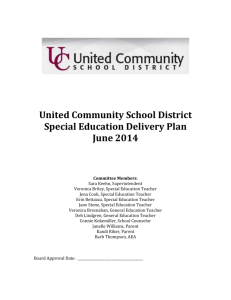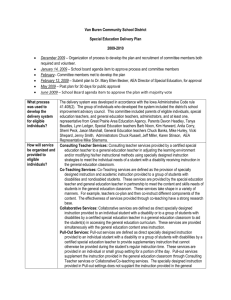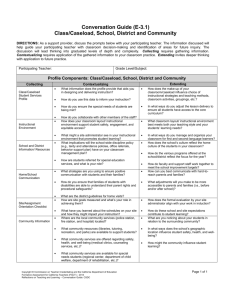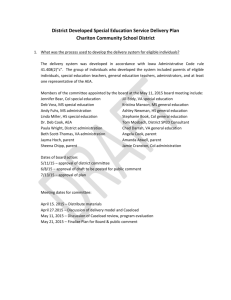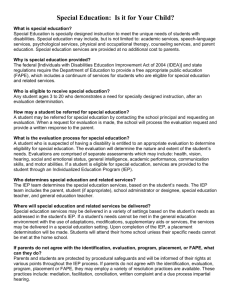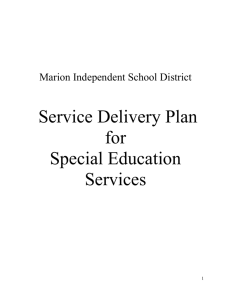LM Sp Ed Service Delivery Plan Final 6 04 09
advertisement
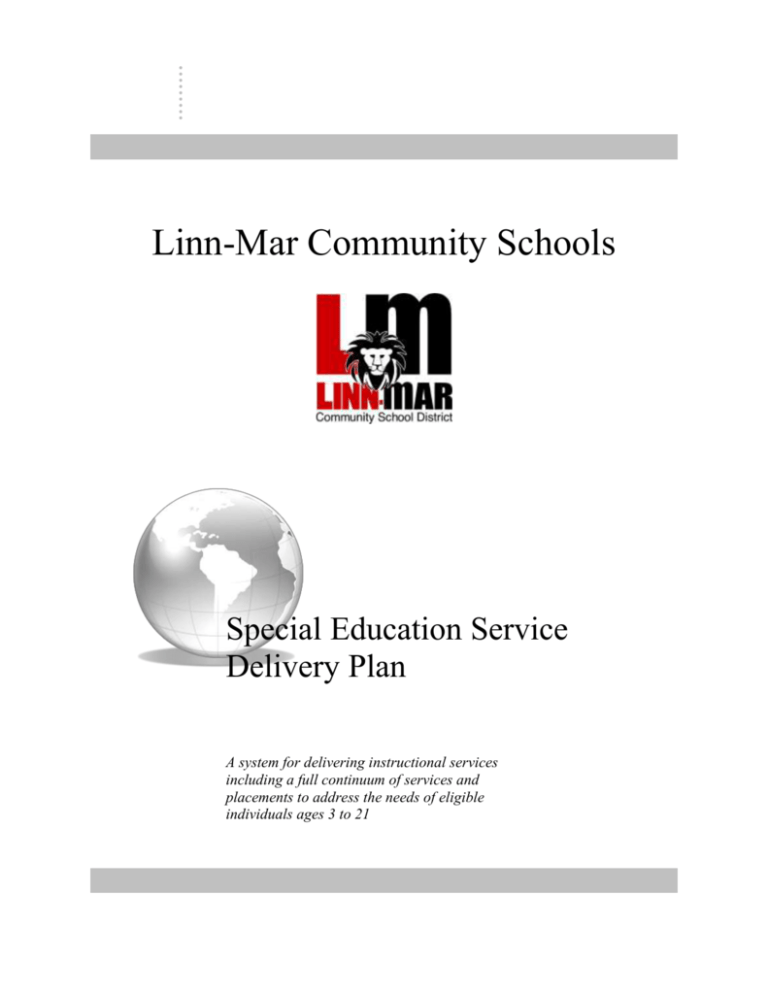
Linn-Mar Community Schools Special Education Service Delivery Plan A system for delivering instructional services including a full continuum of services and placements to address the needs of eligible individuals ages 3 to 21 Table of Contents Committee Members . . . . . . . . . . . . . . . . . . . . . . . . . . . . . . . . . . . . . . . . . . . . . . . . . . . . . . . . . . . . 3 What process was used to develop the delivery system for eligible individuals? . . . . . . . . . . . . . .4 How will services be organized and provided to eligible individuals age 3 -21? . . . . . . . . . . . . . .5 How will caseloads of special education teachers be determined and regularly monitored? . . . . . 8 What procedures will a special education teacher use to resolve caseload concerns?. . . . . . . . . .10 How will the delivery system for eligible individuals meet the target identified in the state’s performance plan and the LEA determination as assigned by the state?. . . . . . . . . . . . . . . . . . . . 11 What process will be used to evaluate the effectiveness of the delivery system for eligible individuals? . . . . . . . . . . . . . . . . . . . . . . . . . . . . . . . . . . . . . . . . . . . . . . . . . . . . . . . . . . . . . . . . . . 11 Assurances . . . . . . . . . . . . . . . . . . . . . . . . . . . . . . . . . . . . . . . . . . . . . . . . . . . . . . . . . . . . . . . . . . .12 5/2009 Page 2 Committee Members Parent Representatives: Nanci Young Kelly VonLehmden Susan Gilliland Special Education Representatives: Jessica Smitterbergh Stephanie Beeler Christine McSweeney Ivan Gentry Peggy Wakefield Sue Hershner General Education Representatives: Renee Wheaton Jennifer Frimml Kelly Kretschmar Administrative Representatives: Jeff Gustason Kristi Hicks John Zimmerman Dan Ludwig Julie Jensen Grant Wood AEA Representatives: Janel Lesan Jean Monroe Debbie Mills 5/2009 Page 3 What process was used to develop the delivery system for eligible individuals? Iowa Administrative Code Rule 41.408(2)”C” The delivery system was developed in accordance with Iowa Administrative Code rule 41.408(2)”c”. The group of individuals who developed the system included parents of eligible individuals, special education teachers, general education teachers, administrators, and at least one representative of the AEA. On Monday, March 9, 2009, the Linn-Mar Community School District Board of Education approved the committee members and the process to complete a Special Education Service Delivery Plan for Linn-Mar community Schools. In the state of Iowa, all districts are required to develop a plan by September 14, 2009. The approved Service Delivery Plan must be inserted into the Comprehensive School Improvement Plan (CSIP) by September 15, 2009. Overview of steps in completing this Service Delivery Plan: Step 1: The district school board approves the development of Service Delivery Plan and individuals on development committee. Step 2: The committee develops the plan. Step 3: The plan is available for public comment. Step 4: The AEA Special Education Director verifies plan compliance. Step 5: The district school board approves the plan prior to adoption. Step 6: The plan is included in the designated area of the CSIP. Step 7: The plan is reviewed in connection with the 5 year accreditation cycle or earlier if required by determination given by the state. 5/2009 Page 4 How will service be organized and provided to eligible individuals age 3 through age 21? Early Childhood Special Education The Linn-Mar Community School District has instructional services and placements for preschool children in a regular early childhood program. Children are served in the regular early childhood classroom by a teacher who holds a valid practitioner’s license that includes pre-kindergarten and early childhood special education. The teacher is responsible for direct instruction, preparation of materials, adaptations and accommodations in implementing the IEP. The Linn-Mar Community School District’s regular early childhood program will implement the criteria of the Iowa Quality Preschool Program Standards General Education with Special Education Support: The student is served in the general education classroom without accommodations/modifications to the curriculum, instruction, testing or grading. The service provider is responsible for consulting with general education teacher and monitoring the student’s progress according to the IEP. (Example: Students served by support only IEPs such as speech/language services.) General Education with Collaboration: The student is served in the general education classroom with collaborative support from the special education teacher. The general education teacher is responsible for direct instruction, testing, grading, and behavior management as specified in the IEP. The special education teacher support may include assisting the general education teacher with the design and preparation of materials, accommodations or curriculum. The special education teacher is responsible for monitoring student IEP progress. (A student with a reading IEP goal may not need accommodations in a math class but may need accommodations in written language activities.) General Education with Co-Teaching Special Education Services in the General Classroom: The student receives special education support for the general education curriculum in the general education setting. The special education teacher, support service provider or trained teacher associate, will be in the general education classroom to provide direct instruction, instructional support or assistance, to the student or group of students through co-teaching models. The special education teacher is responsible for monitoring student progress on IEP goals. (Example: A reading disability student being serviced with direct instruction in the reading classroom by both the special education and general education teacher.) 5/2009 Page 5 General Education with Collaboration/Co-Teaching in the General Classroom and Direct Instruction Outside Education Classroom: The student receives special education support for the general education curriculum in the general education setting. The special education teacher, support service provider or trained teacher associate, will be in the general education classroom to provide direct instruction, instructional support or assistance to the student or group of students through collaborative models. In addition, the special education teacher or service provider support general education curriculum by providing direct instruction outside the general classroom in a separate education setting in needed goal areas. (Example: A reading disability student receives collaborated instruction in the general classroom and also receives direct reading services in a small group setting.) General Education with Direct Special Education Instruction Outside the General Education Classroom: The student receives special education support for the general education curriculum outside the general education setting. When the services cannot be appropriately provided in the general education setting, the student may receive selected services or all services he/she needs in a separate educational setting (including, but not limited to special classes, special schools, home instruction and instruction in hospitals and institutions.) The special education teacher/service provided is responsible for monitoring the student’s progress on IEP goals. (Example: A student with reading, math, and written language, IEP goals receives all areas of direct instruction in a segregated setting by a special education teacher.) 5/2009 Page 6 General Education Collaborative Services Special Education Support Co-Teaching Services Special Education Support Special Education 5/2009 Page 7 How will caseloads of special education teachers be determined and regularly monitored? Caseloads will be tentatively set in the spring for the following year. Caseloads may be modified based on summer registration and actual fall enrollments. Caseloads will be reviewed at least twice during the school year by individual district special education teachers with their building principal and/or Executive Director Student Services. In determining teacher caseloads, the Linn-Mar Community School District will use the following values to assign points to the programs of each eligible individual receiving an instructional program in the district. A teacher may be assigned a caseload within a range up to 150 – 200 total points. This caseload limit may be exceeded by no more than 10% for a period of no more than eighteen weeks, if doing so does not prevent the teacher’s ability to provide the services and supports specified in his or her student’s IEPs. 5/2009 Page 8 Caseload Determination Teacher: _________________________ Curriculum Student: _________________________ Building(s)__________________ Specially Designed Instruction/IEP Goals Student requires no specially designed instruction, and/or Student has IEP goals instructed by another teacher or service provider Joint Planning & Consultation Paraprofessional Support Assistive Technology Behavioral Supports (FBA, BIP, etc.) Joint planning is typical for that provided all students Individual support needed similar to peers Assistive technology use is similar to peers Student requires no behavioral supports Zero Points Student is functioning in the general education curriculum at level similar to peers One Point Student requires limited accommodations to general curriculum 25% or less of instruction is specially designed, and/or delivered by special education personnel and/or Student has 1-2 IEP goal areas Special education teachers conduct joint planning with 1 general education teacher or paraprofessional over the course of each month Additional individual support from an adult is needed for 25% or less of the school day Assistive technology requires limited teacher-provided individualization and/or training for the student Requires limited time assessment, planning, data collection and communication with others (not more than 2 hours per month) Two Points Student requires significant accommodations and/or modifications to general curriculum 26-75% of instruction is specially designed, and/or delivered by special education personnel and/or Student has 3 IEP goal areas Special education teachers conduct joint planning with 2-3 general education teachers or paraprofessionals over the course of each month Additional individual support from an adult is needed for 26-75% of the school day Assistive technology requires extensive teacher-provided individualization and/or training for the student Requires 2-4 hours monthly for assessment, planning, data collection and communication with others Three Points Student requires significant modifications to grade level curriculum and specialized instructional strategies. Alternate assessment is used to measure progress 76% or more of instruction is specially designed, and/or delivered by special education personnel and/or Student has 4+ IEP goal areas Special education teachers conduct joint planning with more than 3 general education teachers or paraprofessionals over the course of each month Additional individual support from an adult is needed 76% or more of the school day Assistive technology requires extensive teacher-provided individualization and/or training for the student. Significant maintenance and/or upgrades for continued effective use are anticipated Requires more than 4 hours monthly for assessment, planning, data collection and communication with others Additional Information: 5/2009 Page 9 What procedures will a special education teacher use to resolve caseload concerns? Ongoing Process Teacher caseloads will be reviewed at least 2 times per year by the building principal and/or Executive Director of Student Services using the caseload determination form Upon review, if there appears to be an overload, the building principal will take the following steps: o Informal problem solving strategies related to caseload concern o Call a meeting of the caseload committee Building Principal Executive Director of Student Services AEA Consultant/Representative o Caseload committee will make recommendations as to whether or not adjustments need to be made to the teacher’s roster Request Process Submit a written request to the building principal at any time Person submitting request is responsible for gathering relevant supporting information Procedural Steps in the Request Process 1. 2. 3. 4. 5. 6. 7. 8. 9. Informal problem solving strategies are exhausted by teacher Written request for caseload review is submitted to the building principal Within 10 working days the building principal tries to resolve the concern If caseload concerns are not satisfactorily resolved, request is sent to caseload committee Within 15 working days the caseload committee will review the request and provide recommendations to the building principal Within 10 working days of receiving the recommendations from the caseload committee, the principal will meet with the teacher and provide a written determination. If the teacher requesting the review does not agree with the determination, they may appeal in writing to the Executive Director of Student Services. The Executive Director of Student Services will meet with personnel involved and provide a written determination. If the teacher requesting review does not agree with the determination, they may appeal in writing to the AEA Director of Special Education. 5/2009 Page 10 How will the delivery system for eligible individuals meet the targets identified in the state’s performance plan and the LEA determination assigned by the state? What process will be used to evaluate the effectiveness of the delivery system for eligible individuals? State Performance Plan Targets and Service Delivery Plan Effectiveness At least once per year, district administrators and staff will examine their special education district profile to review the district’s data relative to progress indicators outlined in Iowa’s State Performance Plan (SPP) for special education. District administrators will also examine the district’s Annual Progress Report (APR) each year to review achievement data as it pertains to students with IEPs in the district. These data will be used to determine needs and priorities and to develop an action plan for special education instructional services when necessary. If the district meets or exceeds APR goals and target goals outlined in our state performance plan for special education, the delivery system will be considered effective. If the district does not meet APR goals or SPP target goals, district staff will work in collaboration with Grant Wood AEA 10 staff to develop an action plan designed to promote progress toward these goals. 5/2009 Page 11 Special Education Service Delivery Plan Assurances The district assures it provides a system for delivering instructional services including a full continuum of services and placements to address the needs of eligible individuals aged 3 to 21, and shall provide for the following: (1) The provision of accommodations and modifications to the general education environment and program, including settings and programs in which eligible individuals aged 3 through 5 receive specially designed instruction, including modification and adaptation of curriculum, instructional techniques and strategies and instructional materials. (2) The provision of specially designed instruction and related activities through cooperative efforts of the special education teachers and general education teachers in the general education classroom. (3) The provision of specially designed instruction on a limited basis by a special education teacher in the general classroom or in an environment other than the general classroom, including consultation with general education teachers. (4) The provision of specially designed instruction to eligible individuals with similar special education instructional needs organized according to the type of curriculum and instruction to be provided, and the severity of the educational needs of the eligible individuals served. The district assures that Linn Mar Community School Board has approved the development of the plan for creating a system for delivering specially designed instructional services. The district assures prior to the school board adoption, this delivery system was available for comment by the general public for at least 14 days. The district assures this delivery system plan was developed by a committee that included parents of eligible individuals, special education teachers, general education teachers, administrators, and at least one AEA representative (selected by the AEA Special Education Director). The district assures the AEA Special Education Director verified the delivery system is in compliance with the Iowa Administrative Rules of Special Education. The district assures the Linn Mar Community School Board has approved the service delivery plan for implementation. 5/2009 Page 12
